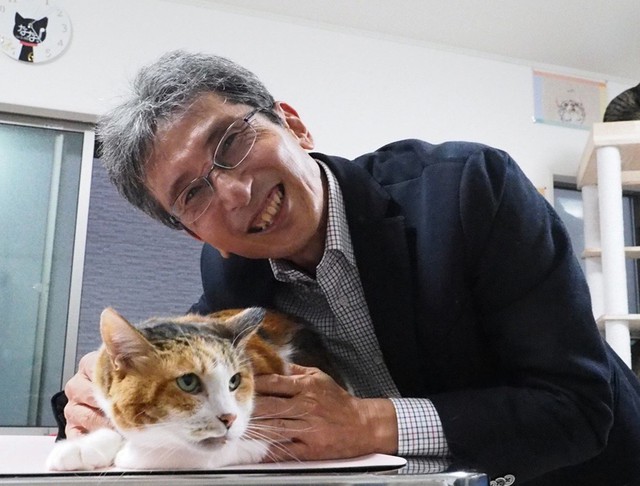
Japan team finds gene determining calico cat color patterns
TOKYO -- A Japanese research team led by Kyushu University professor Hiroyuki Sasaki has said it discovered a gene that determines the color patterns of the tricolored calico cat, known in Japan as 'mike neko.'

Professor Hiroyuki Sasaki of Kyushu University pictured with a calico cat. Photo: Courtesy of Sasaki
The team found that the coloring was decided by the ARHGAP36 gene on the X chromosome. The orange coloration reflects a missing portion of this gene, while the black fur color is due to the absence of such a deletion, the team said.
The team's findings were published in the online edition of the U.S. journal Current Biology on Thursday.
It was established some 120 years ago that almost all calico cats are female and that the color-deciding factor was in the X chromosomes. About 60 years later, researchers discovered that one of the two X chromosomes is inactivated in calico cats.
But the gene responsible for the distinct coloration long remained unidentified.
"As a dog and cat lover, I couldn't let this long-standing mystery go unsolved," Sasaki said.
He said that some of the team's research costs were funded through crowdfunding between 2022 and 2023, raising over 10 million yen from 600 people.
"I think that there is no doubt (that ARHGAP36 is behind the coloration) as a research team from Stanford University in the United States also identified the same gene and announces it at the same time as us," he said.
Sasaki's team, which includes members from Kyushu University, the National Institute of Genetics, Azabu University and Kindai University, extracted and analyzed DNA from cats of many different colors, with the help from an animal hospital in Fukuoka in the Kyushu southwestern region.
The team also examined data on cat DNA made available by the University of Missouri before discovering the ARHGAP36 gene.
The team said that a deletion of about 5,000 base pairs of the ARHGAP36 gene on the active one of the X chromosomes results in the production of pheomelanin, which is orange in color, while the gene without such a deletion creates the black pigment eumelanin.
Like calico cats, tortoiseshell cats, or 'sabi neko,' are mostly female. Tortoiseshell cats also share the same coloring phenomenon.
Orange cats are mainly male, possessing one X chromosome and one Y chromosome. Their orange coloration, too, is due to the ARHGAP36 gene deletion on the X chromosome.
The rare male calico cats have one extra chromosome, possessing two X chromosomes and one Y chromosome.
The white coloration in cats, however, is not the ARHGAP36 gene's doings but is caused by a different gene.
Domestic cats are descendants of the African wildcat that were domesticated by about 10,000 years ago. Similar to a brown tabby cat, the African wildcat has brown-black striped fur.
The team suggested that it may be able to pinpoint when the ARHGAP36 gene deletion happened by assessing mummies and pictures of ancient cats.
Jiji Press
Link nội dung: https://news.tuoitre.vn/japan-team-finds-gene-determining-calico-cat-color-patterns-10325051616510029.htm
